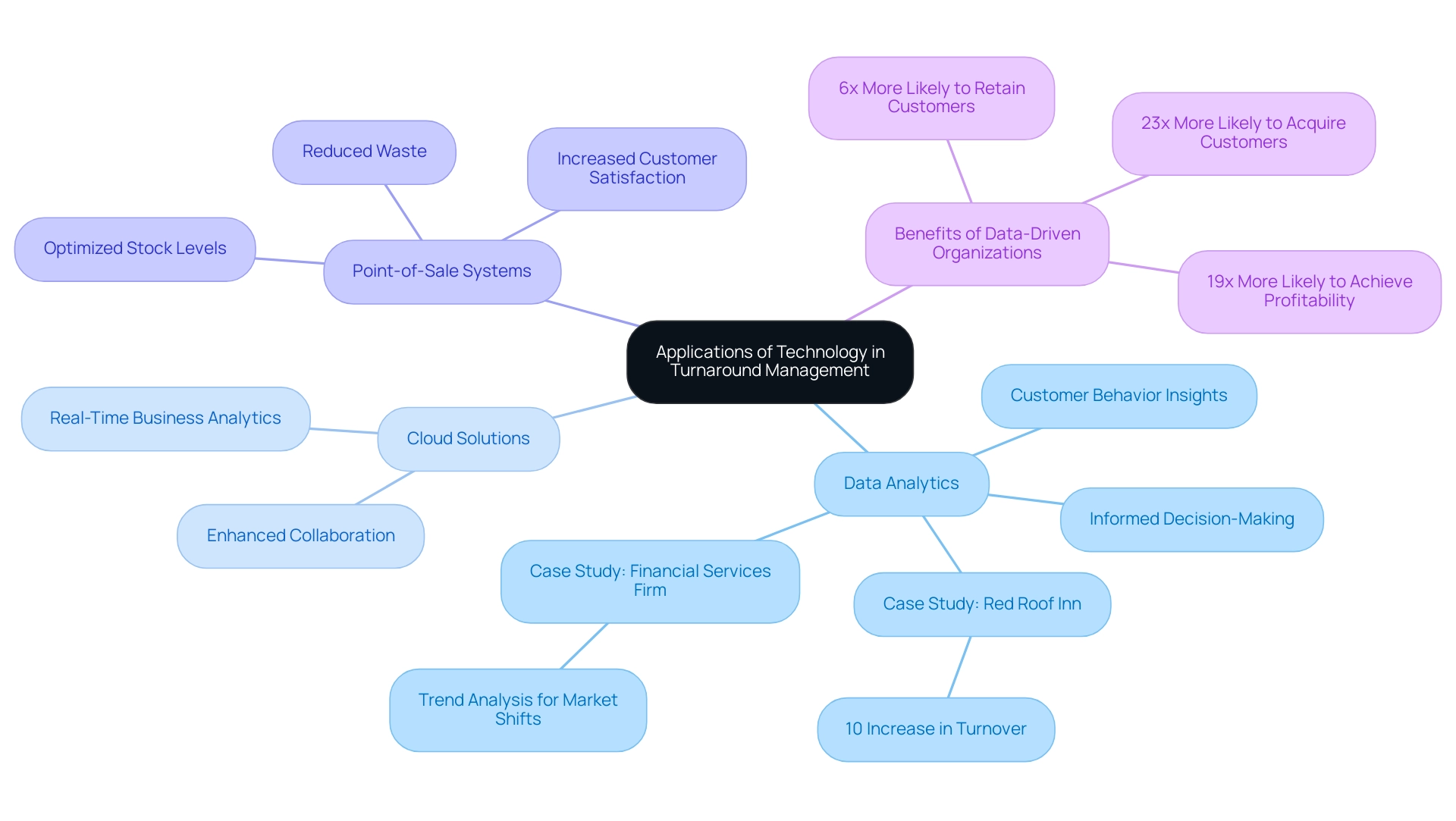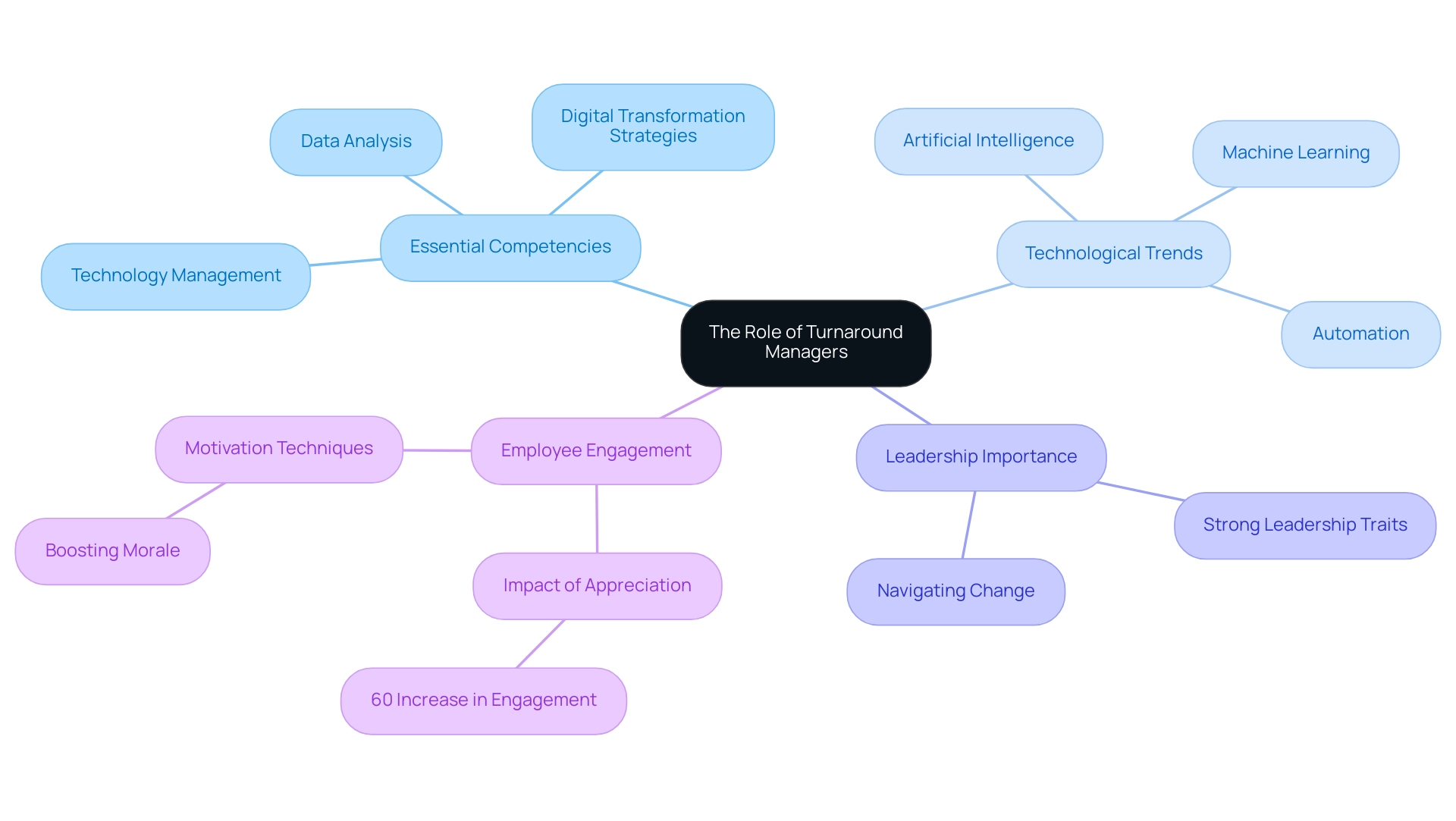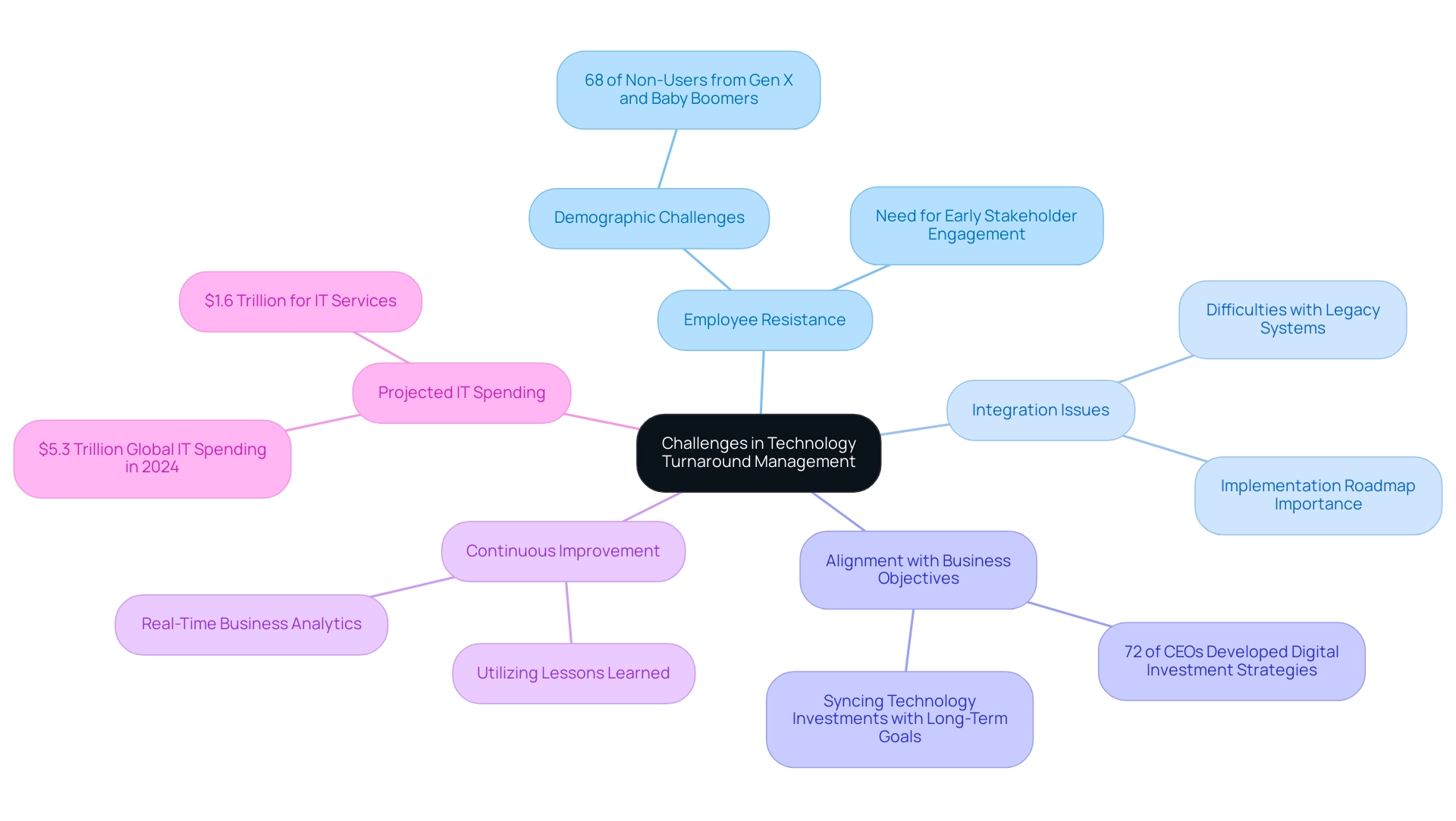Introduction
In an age where technology is a cornerstone of business resilience, organizations are increasingly turning to technology turnaround management as a strategic imperative. This framework not only addresses the immediate challenges of financial distress and operational inefficiencies but also paves the way for sustainable growth in an ever-evolving digital landscape.
By rigorously assessing existing technological assets and implementing innovative solutions, companies can enhance profitability while navigating the complexities of today's market.
As the demand for skilled professionals in digital transformation surges, the ability to integrate advanced technology into turnaround strategies becomes a critical differentiator.
This article delves into the multifaceted aspects of technology turnaround management, exploring its applications, the evolving role of turnaround managers, the challenges faced, and the trends shaping its future.
Embracing these insights is essential for organizations aiming to not just survive but thrive amid disruption.
Defining Technology Turnaround Management: A Critical Overview
Technology turnaround management is a critical strategic framework that organizations leverage to navigate the complexities of financial distress and operational inefficiencies. This approach begins with a thorough assessment of existing technological assets, pinpointing gaps that hinder performance, and implementing innovative solutions designed to boost profitability. A pragmatic approach to data testing is essential; we rigorously test every hypothesis to deliver maximum return on invested capital in both the short and long term.
Efficient decision-making is essential; our team facilitates a shortened decision-making cycle throughout the recovery process, enabling decisive actions that maintain business health. The COVID-19 pandemic has accelerated digital transformation initiatives by an average of six years, leading to a heightened demand for professionals who can manage financial and operational challenges during turnarounds. As highlighted by Piotrowski's insights, approximately 4 million digitally enabled positions are expected to emerge, emphasizing the urgent need for expertise in this area.
Veeam aptly notes, 'Lack of skills and expertise is the most common digital transformation hurdle,' underscoring the critical need for organizations to cultivate talent capable of driving these initiatives. Continuous performance monitoring is supported through our client dashboard, offering real-time analytics to assess your organization's health. Our commitment to operationalizing lessons learned ensures that we build strong, lasting relationships with our clients, fostering continuous improvement.
The case study titled 'Job Growth in Digital Transformation' illustrates significant job growth in digital transformation roles over the last five years, which is essential for businesses in sectors such as employment services, financial services, and media. By strategically incorporating technology turnaround management into recovery plans, companies not only focus on prompt rehabilitation but also lay the groundwork for long-term sustainability through continuous enhancement and operational optimization. This management discipline is essential not just for survival, but for thriving in an increasingly competitive digital landscape.
Applications of Technology in Turnaround Management: Enhancing Efficiency and Effectiveness
In the field of management reforms, technology turnaround management is essential for streamlining operations and enhancing efficiency. Mastering the cash conversion cycle entails implementing approaches that leverage data analytics tools, which provide deep insights into customer behavior, enabling organizations to make informed decisions about product offerings and targeted marketing methods. For instance, Red Roof Inn effectively utilized data related to flight cancellations and weather patterns to identify marketing opportunities, resulting in a remarkable 10% increase in turnover.
Likewise, a financial services company utilized trend analysis to anticipate stock market changes, enabling them to quickly modify their investment approaches, demonstrating the proactive capability of data analytics in recovery situations. Furthermore, real-time business analytics play a critical role in operationalizing lessons learned throughout the recovery process, as they allow teams to continually monitor the success of implemented plans. Cloud-based solutions further enhance collaboration and communication among teams during critical phases.
Industries such as retail and hospitality have experienced substantial benefits by integrating point-of-sale systems with inventory management software, optimizing stock levels and reducing waste. These technological applications not only improve operational effectiveness but also drive significant cost savings and elevate customer satisfaction. The significance of precise data gathering and analysis cannot be overstressed; it is crucial for informed decision-making and preventing unproductive approaches.
As emphasized by the McKinsey Global Institute, entities that are data-driven are:
- 23 times more likely to acquire customers
- Six times more likely to retain them
- 19 times more likely to achieve profitability
This highlights the importance of adopting advanced technological solutions in technology turnaround management. Furthermore, our extensive solutions are listed at $99.00, and they include 20 strategies for optimal business performance, ensuring that organizations can effectively navigate the complexities of management recovery while fostering strong, lasting relationships through the operationalization of lessons learned.

The Evolving Role of Turnaround Managers: Skills and Trends in a Technological Landscape
In an era marked by rapid technological advancement, the role of change managers in technology turnaround management is experiencing a significant transformation. Today's successful transformation specialists must integrate technology turnaround management by blending traditional management capabilities with advanced technical skills, particularly in streamlined decision-making and real-time analytics. Essential competencies include:
- Data analysis
- The development of digital transformation strategies
- Effective technology turnaround management
A strong understanding of emerging technologies such as artificial intelligence, machine learning, and automation is imperative for maximizing return on invested capital. Furthermore, turnaround managers are tasked with cultivating a culture of innovation through technology turnaround management, which encourages teams to embrace new technologies and processes that drive efficiency and engagement. They must also prioritize continuous performance monitoring through client dashboards, which offer real-time analytics that diagnose organizational health.
This real-time insight is crucial for testing hypotheses and making informed decisions that enhance organizational performance. With 60% of U.S. employees lacking conflict management training, strong leadership becomes crucial during organizational shifts. As noted, 'By embodying these traits and qualities, leaders can navigate through challenging times and lead their organizations to success.'
This highlights the importance of leadership in fostering a supportive environment. Additionally, studies show that appreciation in the workplace can significantly increase employee engagement—by 60%—demonstrating how motivated teams can enhance overall business performance. The case study on employee motivation indicates that lack of appreciation is a top complaint among employees, underscoring the need for managers to prioritize employee recognition.
By staying updated on industry trends and implementing the lessons learned through recovery processes, including building strong relationships, these managers can strategically position their entities for sustainable growth and resilience.

Challenges in Technology Turnaround Management: Navigating Disruptions and Integration Issues
Incorporating technology into technology turnaround management offers companies a myriad of challenges, despite the potential rewards. Resistance to change from employees often emerges as a significant barrier, particularly among demographics such as Gen X and Baby Boomers, with 68% of non-users belonging to these groups. This highlights the demographic challenges in technology adoption that entities must navigate.
Additionally, integration difficulties with legacy systems complicate efforts to modernize operations. A staggering 72% of CEOs have acknowledged the necessity of developing aggressive digital investment strategies; however, many organizations still grapple with aligning these strategies with overarching business objectives, highlighting the importance of technology turnaround management to avoid fragmented approaches. This disconnect highlights the significance of addressing alignment issues as part of the technology turnaround management recovery process.
To effectively navigate these obstacles, management should prioritize early stakeholder engagement to foster buy-in and clearly communicate the advantages of proposed changes. By addressing employee concerns and demonstrating how new technologies can seamlessly integrate with existing systems, companies can mitigate resistance. Furthermore, ensuring that technology investments are in sync with technology turnaround management and long-term strategic goals is crucial.
Establishing a detailed implementation roadmap not only mitigates potential disruptions but also facilitates a smoother transition. In this context, our team supports a streamlined decision-making cycle throughout the recovery process, allowing your organization to take decisive actions quickly. We continually monitor performance through our client dashboard, providing real-time business analytics to assess ongoing health and success.
Our dedication to implementing lessons learned guarantees that insights acquired during the recovery process are utilized in future initiatives, promoting continuous improvement and stronger relationships with stakeholders. As projected IT spending reaches $5.3 trillion globally in 2024, with a notable $1.6 trillion earmarked for IT services, the emphasis on technology turnaround management to overcome these integration challenges becomes more pressing. This forecast demonstrates the strong increase in IT expenditure, reflecting continuous investments in technology across different sectors, which companies must leverage through technology turnaround management to improve their recovery strategies.

The Future of Technology in Turnaround Management: Trends and Innovations to Watch
As we look toward 2024, several pivotal trends and innovations are set to redefine technology in management. The proliferation of artificial intelligence and machine learning is anticipated to revolutionize predictive analytics, empowering entities to make informed decisions and optimize resource allocation efficiently. Given the pace of AI evolution, as one expert aptly noted, 'The time to start onboarding your agents is now.'
However, fewer than one-third of entities expect new digital investments for climate and trade regulations, highlighting a cautious investment climate that could impact turnaround strategies. By applying a rigorous testing approach to hypotheses, organizations can maximize returns on invested capital, ensuring that every decision is data-driven and strategically sound. The concept of an agent bill of materials can assist organizations in tracking and understanding agent decision-making, which is crucial for leveraging AI and machine learning effectively.
Furthermore, real-time analytics will consistently oversee these approaches, enabling rapid modifications to maintain organizational well-being. The escalating significance of cybersecurity will compel organizations to invest in robust security measures, safeguarding sensitive data throughout transitional phases. Moreover, organizations must steer clear of disjointed AI applications and thoughtfully reconsider essential operational procedures to adopt more responsive and adaptable recovery approaches.
To navigate this dynamic landscape successfully, embracing these technological trends is not merely advantageous but essential for achieving measurable business outcomes in technology turnaround management. Explore our comprehensive guide, 'Revolutionizing Operations With AI & Machine Learning,' available now for $399.00, and discover methodologies like 'Test & Measure' and 'Decide & Execute' to enhance your operational strategies.
Conclusion
Embracing technology turnaround management is not just a response to immediate challenges; it is a strategic necessity for organizations aiming to foster sustainable growth in today's rapidly evolving digital landscape. By thoroughly assessing technological assets and implementing innovative solutions, companies can address financial distress and operational inefficiencies while positioning themselves for long-term success.
The integration of data analytics, real-time business insights, and cloud-based solutions has proven to enhance operational efficiency and effectiveness across various industries. These tools empower organizations to make informed decisions, optimize resource allocation, and ultimately drive profitability. As turnaround managers evolve in their roles, the importance of blending traditional management skills with advanced technological competencies becomes increasingly clear.
However, challenges such as resistance to change and integration difficulties with legacy systems must be navigated carefully. Early stakeholder engagement and clear communication about the benefits of new technologies are crucial for overcoming these barriers. By establishing a detailed implementation roadmap and continuously monitoring performance, organizations can ensure that their technology investments align with long-term strategic goals.
Looking ahead, the future of technology in turnaround management is bright with opportunities for innovation. Organizations that harness the power of artificial intelligence, machine learning, and robust cybersecurity measures will be better equipped to adapt and thrive amid disruption. To remain competitive, it is essential to embrace these trends and develop a proactive approach to technology integration. The time for decisive action is now; organizations that prioritize technology turnaround management will not only survive but thrive in the face of change.
Frequently Asked Questions
What is technology turnaround management?
Technology turnaround management is a strategic framework that organizations use to address financial distress and operational inefficiencies by assessing existing technological assets, identifying performance gaps, and implementing innovative solutions to enhance profitability.
Why is data testing important in technology turnaround management?
A pragmatic approach to data testing is essential as it rigorously tests hypotheses to ensure maximum return on invested capital in both the short and long term.
How does decision-making affect the recovery process in organizations?
Efficient decision-making is crucial; it facilitates a shortened decision-making cycle during the recovery process, allowing for decisive actions that help maintain business health.
How has the COVID-19 pandemic impacted digital transformation?
The pandemic has accelerated digital transformation initiatives by an average of six years, increasing the demand for professionals capable of managing financial and operational challenges during turnarounds.
What is the significance of talent in digital transformation?
According to Veeam, the lack of skills and expertise is the most common hurdle in digital transformation, highlighting the need for organizations to cultivate talent that can drive these initiatives.
How does continuous performance monitoring work in technology turnaround management?
Continuous performance monitoring is supported through a client dashboard that provides real-time analytics to assess an organization’s health.
What is the role of data analytics in technology turnaround management?
Data analytics tools provide deep insights into customer behavior, enabling informed decisions about product offerings and targeted marketing, thereby enhancing operational efficiency.
Can you provide an example of successful data utilization in a business?
Red Roof Inn used data related to flight cancellations and weather patterns to identify marketing opportunities, resulting in a 10% increase in turnover.
What benefits do industries like retail and hospitality gain from technology integration?
These industries benefit from integrating point-of-sale systems with inventory management software, optimizing stock levels, reducing waste, improving operational effectiveness, and elevating customer satisfaction.
What are the advantages of being a data-driven organization?
Data-driven entities are 23 times more likely to acquire customers, six times more likely to retain them, and 19 times more likely to achieve profitability.
What resources are available for organizations looking to improve business performance?
Organizations can access extensive solutions priced at $99.00, which include 20 strategies for optimal business performance to assist in navigating management recovery complexities.




